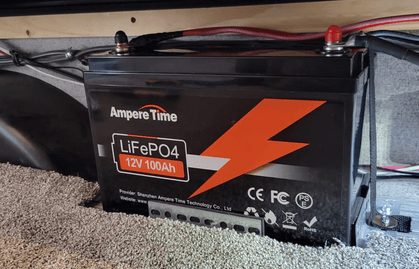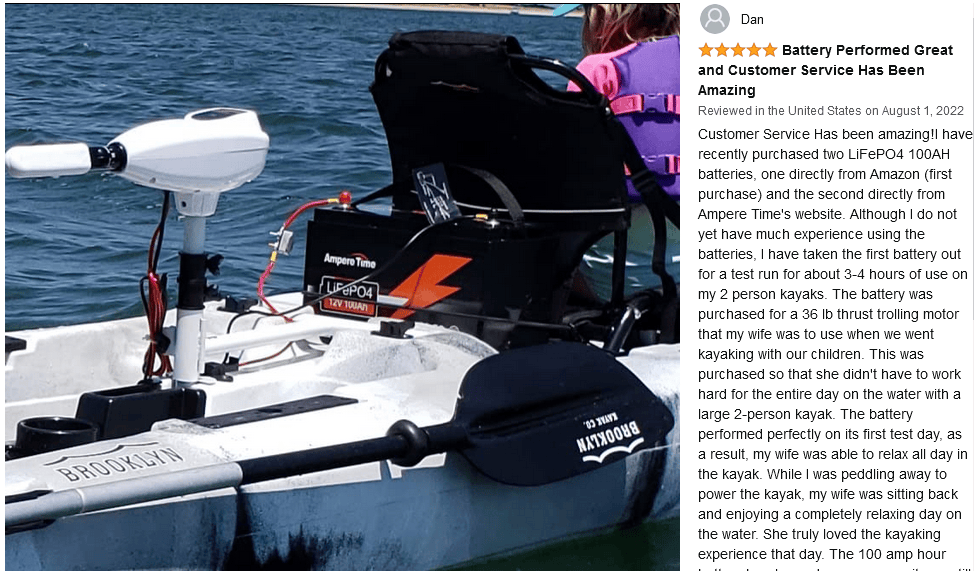In this review, we’ll explore the best lithium batteries for trolling motors, comparing top products and discussing key factors to consider. By the end, you’ll know which battery is perfect for your boating needs.
At the end of the article we will take a look at factors to consider when choosing the best lithium battery for trolling motors:
- Battery capacity and voltage
- Battery weight and size
- Charging time and efficiency
- Cycle life and durability
- Safety features
- Price and warranty
Comparison of the Best Lithium Batteries for Trolling Motor
| Best Overall | Best Waterproof |
 |
 |
| Li Time | SOK Marine Grade |
| Good build quality, reliability, Warranty, and price | Best value for money as a marine waterproof battery |
| 12V 100Ah |
12V 100Ah |
| No bluetooth app | Bluetooth app |
| 5 years warranty | 7 years warranty |
| Not waterproof | Waterproof |
Li Time

The LiTime battery company is formerly known as AmpéreTime. They have rebranded their company but kept the same good customer service.
Li Time Battery Company is a reputable manufacturer of high-quality lithium batteries specializing in Lithium Iron Phosphate (LiFePO4) technology. They focus on providing efficient and reliable power solutions for various applications, including trolling motors, renewable energy systems, and electric vehicles.
Their mission is to deliver innovative and environmentally friendly products that meet the growing demand for energy storage solutions. They invest heavily in research and development, striving to improve their batteries’ performance, safety, and longevity.

Li Time’s batteries are known for their high energy density, long cycle life, and fast charging capabilities. Their products are designed to emphasize safety, incorporating built-in battery management systems (BMS) to protect against overcharging, over-discharging, and short circuits.
The company is committed to providing exceptional customer service, offering technical support, and addressing any concerns their customers may have. By continuously improving its products and services, Li Time aims to become a leading player in the lithium battery industry.

Overview and specifications
Capacity: 100Ah
Voltage: 12V
Cycle life: 6000+ cycles
Weight: 24.25 lbs
Dimensions: 13 x 6.77 x 8.43 inches
Charging time: 5 hours with 20A charger
Pros
- 5 years warranty
- Long cycle life
- Lightweight design
- Fast charging time
- Built-in battery management system (BMS)
- Can be connected in series up to 48V
- Can be connected in parallel
Cons
- Higher upfront cost compared to lead-acid batteries
- Limited availability because of popularity
- No Bluetooth app

Recommended use
Use this battery if you have a compartment in your boat which you can seal so no water comes into contact with the battery.
SOK Marine Grade

SOK Battery is a reliable and innovative company in the lithium battery market. They are committed to producing high-quality LiFePO4 batteries for various applications, making them an excellent choice for dependable, long-lasting power solutions.
Overview and specifications
Capacity: 100Ah
Voltage: 12V
Cycle life: 6000+ cycles
Weight: 27 lbs
Dimensions: 11.53×6.69×8.58 inches
Charging time: 5 hours with 20A charger
Pros
- 7 years warranty
- Water and dustproof
- Serviceable battery (you can open the lid)
- Connects to Bluetooth app to see the state of charge
- Long cycle life
- Lightweight design
- Fast charging time
- Built-in battery management system (BMS)
- Can be connected in series up to 48V
- Can be connected in parallel
Cons
- Higher cost
Recommended use
Use this battery if you don’t have a dedicated battery compartment on your boat.
Conclusion
Choosing the best lithium battery for your trolling motor is a crucial decision that can significantly impact your boating experience. Factors such as capacity, discharge rate, durability, and the reputation of the battery manufacturer all play a vital role in ensuring you get the most out of your investment. In this article, we have highlighted some of the top contenders in the market, like the Li Time and SOK marine batteries, both of which offer excellent performance, safety features, and longevity.

Buyers Guide for Trolling Motor Battery
When selecting the best lithium battery for your trolling motor, it’s essential to consider several factors that can impact the battery’s performance and lifespan. Here, we’ll discuss these factors in more detail:
- Battery capacity and voltage: The capacity of a battery, measured in ampere-hours (Ah), determines how much energy it can store and deliver to your trolling motor. A higher-capacity battery will allow you to run your motor for extended periods before recharging. Voltage, on the other hand, impacts your motor’s power output and efficiency. Ensure that the battery’s voltage matches the recommended voltage for your trolling motor. Generally, a 12V, 100Ah battery is enough for several hours of leisure time on the water.
- Battery weight and size: Lithium batteries are generally lighter and more compact than traditional lead-acid batteries, which can be a significant advantage when it comes to the overall weight of your boat. When choosing a battery, consider your boat’s available space and weight capacity, as well as the ease of installation and handling.
- Charging time and efficiency: A battery with a faster charging time and higher efficiency will save you time and energy, allowing you to spend more time on the water. Look for batteries with built-in charge management systems that optimize charging efficiency and protect against overcharging or undercharging.
- Cycle life and durability: The cycle life of a battery refers to the number of charge and discharge cycles it can undergo before its capacity is significantly reduced. A higher cycle life indicates a more durable and long-lasting battery. Opt for batteries with high-quality components and construction that can withstand harsh marine environments, temperature fluctuations, and vibration.
- Safety features: Safety is paramount when dealing with electrical components on a boat. Look for batteries with built-in safety features such as thermal protection, overcharge protection, and short-circuit protection. These features help prevent potential hazards and ensure the battery’s longevity.
- Price and warranty: Lithium batteries can be more expensive upfront than their lead-acid counterparts. However, they often offer better long-term value due to their longer lifespan and higher efficiency. When comparing prices, consider the battery’s overall performance, features, and warranty. A good warranty can provide you with peace of mind and protection for your investment, ensuring that you’ll receive support if any issues arise with your battery.
FAQ
How long will a 100Ah lithium battery last on trolling motor?
To determine how long a 100Ah lithium battery will last on a trolling motor, you’ll need to consider the motor’s power draw. The power draw is typically measured in watts or amps. To calculate the runtime, you can use the following formula:
Runtime (hours) = Battery Capacity (Ah) / Motor Power Draw (amps)
Suppose you have a trolling motor with a power draw of 20 amps. With a 100Ah lithium battery, you can expect the following runtime:
Runtime = 100Ah / 20 amps = 5 hours
Remember that this is a rough estimate, and actual runtime may vary depending on factors such as the efficiency of the motor, the speed setting, and the conditions of the water (e.g., water current, wind, and load on the boat). Additionally, it’s a good practice not to fully discharge the battery to ensure its longevity, so keeping some reserve capacity is recommended.
Yes, you can create a 24V battery system by connecting two 12V batteries in series. To do this, follow these steps:
- Ensure the two batteries have the same state of charge before connecting them in series.
- Place the two 12V batteries next to each other.
- Connect the positive (+) terminal of the first battery to the negative (-) terminal of the second battery using a suitable cable or wire.
- The remaining free positive (+) terminal on the first battery will now serve as the 24V positive output. The free negative (-) terminal on the second battery will serve as the 24V negative output.
By connecting the batteries in series, their voltage adds up while the overall capacity (Ah) remains the same. In this case, the two 12V 100Ah batteries combine to create a 24V 100Ah system.
Can I increase the battery capacity later on?
You can increase the capacity of the battery without changing the voltage.
To increase battery capacity, you need to connect additional batteries in parallel. In a parallel connection, connect the positive (+) terminal of one battery to the positive (+) terminal of another and the negative (-) terminal to the negative (-) terminal of another.


I’m an off-grid enthusiast. I created this website to give clear and straight-to-the-point advice about solar power. I’m also the author of the book ‘Off-grid solar power simplified‘. Read more about me on my about page, check out my Youtube channel, or send me a message.